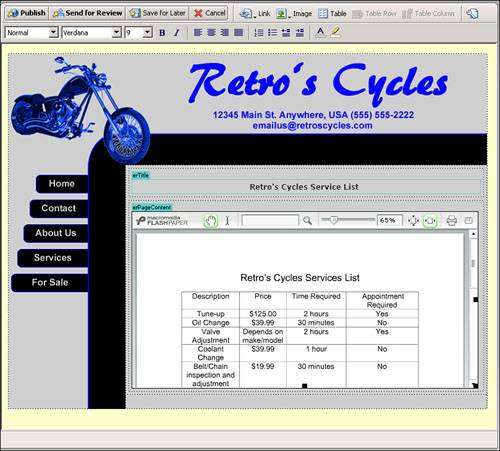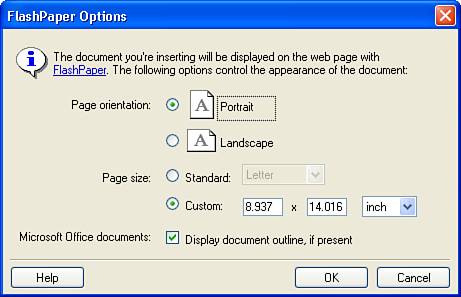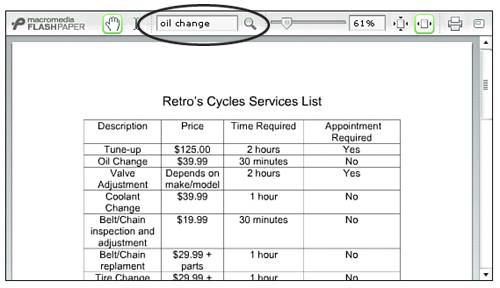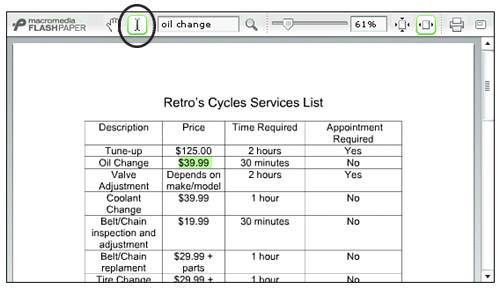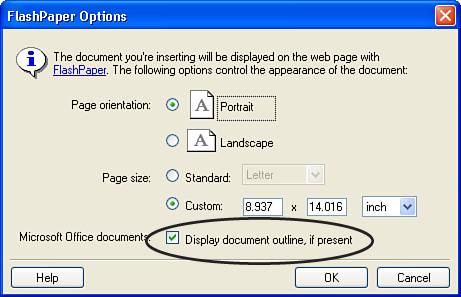In this chapter
FlashPaper 2 is a plug-in application that is automatically installed with Contribute 3. FlashPaper is a new content management tool that converts an existing document into a Flash movie or PDF that can be inserted into any web page. The nice thing about FlashPaper is that the FlashPaper interface enables you to zoom in and out and even search the document text. In addition, by placing the document inside a Flash movie, you can ensure cross-browser compatibility through the use of the Flash Player plug-in.
FlashPaper 2 provides several different methods for converting a document to the FlashPaper format. Documents can be converted from within Microsoft Word, from the Windows Explorer environment, or even from within Contribute.
One easy way to convert your Microsoft Word documents to FlashPaper movies is to use the FlashPaper menu added to Word when FlashPaper was installed. As shown in Figure 33.1, the FlashPaper menu enables you to create a Flash movie or PDF file with the click of your mouse.
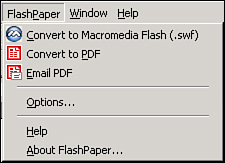
Figure 33.1. The FlashPaper menu is added to Microsoft Word when FlashPaper is installed with Contribute.
After a document has been converted, it can be inserted into any web page as a Flash object.
A second option for converting a document to FlashPaper is to navigate to the document in Windows Explorer and right-click on the document. From the context menu, shown in Figure 33.2, you can choose whether to create a Flash document or PDF document.
Just as it does when converting documents from within Word, the FlashPaper application asks you to select an output destination for the new Flash movie and then converts the document to FlashPaper.
Inserting a FlashPaper document into a web page from within Contribute is a simple process. If you have already created the FlashPaper Flash movie from within Microsoft Word or the Windows Explorer environment, you can add the movie to the page by going to the Contribute menu bar and choosing Insert, Flash, From My Computer. Then browse to the location of the Flash movie and add it to your page. Because the movie was created with the FlashPaper application, it contains the same zoom, search, and print options that all FlashPaper objects have. In addition, the object also has resize handles that enable you to adjust the size of the movie to fit your page design (see Figure 33.3).
If you haven’t converted the document to FlashPaper yet, the other option is to insert the FlashPaper document from within Contribute by using the Insert, Document with FlashPaper command. To convert a document, browse to the file’s location and select it. Contribute then asks you to specify the attributes of the FlashPaper that will be created (see Figure 33.4).
After the FlashPaper is inserted into the page, it is the exact size that you specified in the FlashPaper Options dialog box. If you need to resize the document to fit your page design, drag the resize handles to make any adjustments.
Similar to the interface used to search text in PDF documents, the FlashPaper interface provides a search tool that enables you to find text inside your FlashPaper movies (see Figure 33.5).
To search for text, type your search string in the text box and click the magnifying glass icon to conduct the search. If the first result is not the instance of the keyword or phrase you are looking for, click the magnifying glass again until you find the results you want.
FlashPaper also enables you to select text stored in a FlashPaper document by using the Select Text tool that looks like an IBeam on the toolbar (see Figure 33.6). Using this tool, you can highlight text and copy and paste it into another document by using the Ctrl+C keyboard command in Windows or Command-C in the Mac OS.
Be aware that there is no copy command on the context menu for the FlashPaper file, so the Ctrl+C command is the only way to copy content from a FlashPaper movie. In addition, because you cannot affect the contents of the FlashPaper without republishing it, you cannot cut content from the movie and the Ctrl+X command does not function.
FlashPaper documents are simply snapshots of what your document looked like at the point when the movie was generated. As a result, updates to the base document that you used to generate the FlashPaper do not automatically propagate to the FlashPaper.
This means that when you want to update your FlashPaper content, you need to update the base document, remove the existing FlashPaper document from your page, and then insert a newly generated FlashPaper object. You can also simply save over the existing FlashPaper object and any pages that contain references to that object display the newly created document.
When a FlashPaper object is created, any hyperlinks found in the base document are automatically converted to clickable links in the FlashPaper. Therefore, creating hyperlinks inside a FlashPaper is as simple as selecting the appropriate text and choosing Insert, Hyperlink from within the Word, Excel, or PowerPoint document. Using the corresponding dialog box in that application, create the hyperlink, save the page, and then publish your FlashPaper.
One very handy feature that FlashPaper offers to accommodate long documents is the outline feature. If an outline exists in the base Word document, FlashPaper can create a corresponding outline with clickable links to the various sections based on that outline.
The trick, however, is that you have to use style headings to indicate where the different sections are for the outline to be generated appropriately. So if you have created a particularly long document that could benefit from an outline, be sure that you go through it and assign headings for your different sections.
In addition, in the FlashPaper Options dialog box, be sure to check the Display Document Outline check box, if it is present (see Figure 33.7).
I inserted a FlashPaper document into my page and it was inserted at its native size. This adversely affected my page layout. How can I reduce the size of the FlashPaper object?
There are two ways to resolve this issue. The first is to reconsider the size that you indicated in the FlashPaper attributes. By default, the resulting movie is the same size as the original base document, so decreasing the height and width reduces the object size and probably causes it to fit better into your site design.
The second option is to manually resize the object by clicking on the FlashPaper in Edit mode and resizing it by dragging the resize handles. Following this method enables you to easily control the object’s size and determine which size fits best without having to export the object over and over.
I installed FlashPaper, but now when I try to convert a document I get an error stating that the FlashPaper printer was not found. What can I do?
Most likely, the FlashPaper printer driver did not install correctly on your machine during the FlashPaper installation. You can download the FlashPaper driver from the Macromedia site at http://tofu.macromedia.com/fpinstaller/FlashPaperDriverInstall2.zip. Installing the printer driver manually should resolve the issue.
You may have noticed that FlashPaper is capable of creating PDF documents as well as Flash movies. This might, in turn, spark the question as to which document platform is better and why. Over the last few years, Adobe has really advanced document management by developing the PDF format to its current state. PDFs are excellent because they are snapshots of a document that can be made non-editable. From personal experience in the legal industry, the PDF format has been very useful because documents can be submitted and there is no question about whether or not they have been altered. Other formats, such as Word or Excel documents, don’t offer the same level of security.
The only downside to the PDF format has been the reader required to view the documents. To read a PDF, you have to install the Adobe Reader on your machine, and then, each time you open a PDF document, the Reader application has to open and process the document before either sending it to the browser for rendering or displaying it natively in the Reader application.
FlashPaper is Macromedia’s attempt to improve on this document management model by allowing the document to be captured in a static, uneditable format similar to that of a PDF document, while reducing load time for the document significantly. Because the Flash Player is already installed on the vast majority of machines connected to the web, no additional download or installation is required. In addition, the Flash Player always renders Flash movies in the browser, ensuring that the user doesn’t have to wait for the helper application to initialize and process the document, as is the case with Acrobat Reader.
On the other hand, your users might be accustomed to PDF documents because they have become the standard for document management on the web over the last few years and switching to the FlashPaper model might cause some confusion. Therefore, I would suggest generating and providing access to documents in both formats while the popularity of FlashPaper grows. Then, as your user base becomes more comfortable with using FlashPaper documents instead of PDF documents, you can slowly phase out the PDF versions.


